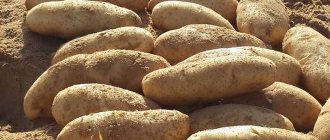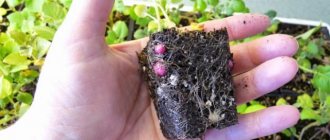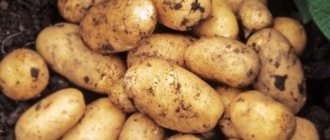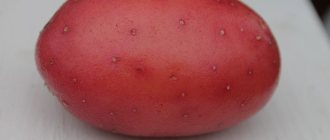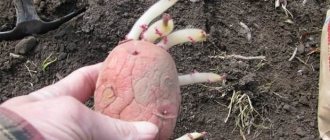Friends, in this material we will tell you in detail about the Luck potato , we will analyze its features and consider the feasibility of sowing. Any farmer, whether he is a novice amateur or an experienced gardener, wants to get a bountiful potato harvest, as early as possible and without sudden pitfalls.
A special type of potato, which is called “Luck,” will satisfy all these desires in the best possible way. If you read in more detail its characteristics, description, photographs and reviews, then there will be no doubt that it is worthy of you planting it on your site. However, if you are an entrepreneur who wants to sell potatoes in stores and markets, then you should also pay attention to these Luck potatoes.
A short excursion into history
The history of the appearance of this potato dates back to the 90s of the last century. Of two different varieties, Russian scientists from the State Scientific Institution All-Russian Research Institute of Potato Farming named after. A.G. Lorch bred potatoes, which would later receive the name “Luck” for its excellent consumer qualities.
The goal of breeding was to create a variety that is well adapted to any conditions, which will produce a rich and tasty harvest, despite external negative factors. The donors were two good potato varieties: Vilnya and Anoka. The efforts of the breeders have paid off: Luck grows and bears fruit well, and adapts well to different soil and climate characteristics. It is grown in Russia in the Central Black Earth, Far Eastern and neighboring regions. This variety is also popular in Moldova and Ukraine. We can safely say that this is one of the most unpretentious and prolific potato varieties in the CIS.
Watering, loosening and fertilizing
The Luck potato harvest can be obtained by practically forgetting about it after planting (not counting hilling), but for minimal care Luck will reward you a hundredfold.
One potato bush takes 100 g of potassium, 50 g of nitrogen and 20 g of phosphorus from the soil per season, they must be replenished!
Caring for potatoes after planting, table
| Watering | Loosening and hilling | Feeding | |
| Active growing season before buds appear | Once a week 10 l/m2 in the evening (in the absence of rain). | When the bushes reach a height of 10 cm - the first hilling, after 2-3 weeks - the second. Hilling is carried out only on moist soil. During the dry period, it is necessary to limit oneself to surface loosening to aerate the soil. The purpose of hilling is to create favorable conditions for the development of tubers in the surface layer of soil. Periodically, weeds are cut with a hoe or flat cutter and left on the ground. | Spraying with ash solution (300 g per 10 liters of water) 2 weeks after emergence. It is held in the evening in dry cloudy weather. Root feeding before hilling: 1 tbsp. spoon of urea per 10 liters of water. Consumption 0.5 l/bush. Combined with irrigation. |
| Budding and flowering | Once a week 20–30 l/m2 in the evening (in the absence of rain). | The last hilling to a height of 17-20 cm is carried out before the tops of the bushes close. The row spacing must be mulched with mown grass or straw. | At the beginning of flowering, 3 tbsp. spoons of superphosphate and wood ash per 10 liters of water. Consumption 1 liter per 1 m of planting under bushes. Spraying with Ovary (2 g per 1.5 liters of water). |
After the bushes have flowered, feeding stops; only moderate watering is done in dry weather.
Description of the potato variety Udacha
The Udacha potato acquired many important consumer properties through the process of crossing: it is resistant to diseases and adapts perfectly to various types of soil and weather conditions. Also, it is the very first to appear on shelves in markets and shops, attracting the attention of buyers with its neat appearance. Yes, if you didn’t know, then the earliest summer potatoes on the markets will be Luck in 90% of cases.
- Bush part. The upper part can be slightly lower than 50 cm. It has a large number of dark green leaves. During flowering, lush white inflorescences with bent petals appear. When the time comes, berries appear to replace the flowers. They are few in number and have seeds.
- Tuberous part. The fruits of this variety are characterized by a round, elongated shape. One of the distinctive features is the small number of small eyes. The color of the tubers can be cream, beige, light brown. Peeling the fruit is very simple and convenient, since it has a thin skin and a minimum of lumpiness. In the middle, the raw fruit is white. When boiled it becomes yellowish in color.
How to grow "Luck"
The main thing that distinguishes the “Udacha” potato from other hybrids and varieties is its unpretentiousness in terms of soil. It grows not only on chernozems, but also on clay soils, loams and sandy loam soils. But potatoes also require some care. For example, the beds need to be prepared in the fall. Potatoes grow best after melons, cabbage and cucumbers. If you plant tubers in the same place for a long time, the risk of disease increases. In addition, the variety is degenerating.
Tubers grow best in soft soil. Therefore, the area intended for planting the variety must be dug up in advance to a depth of 2 cm. At the same time, the soil is fertilized with compost or humus, based on 40 to 45 buckets per 1 hundred square meters.
For clay soils, it is most convenient to plant tubers in pre-formed ridges 15-20 cm high, with a distance between ridges of 70 cm. With such planting, the soil will warm up better. Its breathability will also increase. For chernozems, planting in “ridges” is not necessary, since the soil warms up quite well without it.
Characteristics and photos
- Ripening period: +- 90 days
- Average weight of one fruit: 150 grams
- Average number of tubers per potato plant: 15
- Percentage of starch to total pulp: from 12% to 14%
- Average yield: +-42 tons per hectare of chernozem
- Dependence on temperature changes: low
It is resistant to periods of drought and is not afraid of even extreme high temperatures in the middle zone. It can stably provide 40-45 tons per hectare. Higher fertility rates are possible if organic and chemical fertilizers are used to increase the number and size of tubers.
How to properly care for the variety
Following planting rules alone is not enough to achieve maximum success and optimal yield. To increase productivity, the soil is loosened, hilled, watered and fertilizers are applied in a timely manner. If the potatoes are planted too early, it is best to cover the area with soil material or carry out a mulching procedure using sawdust, dry grass and other organic components.
Features of watering
Tubers do not need to be watered regularly; this variety is absolutely not demanding on timely watering.
If there is heavy rainfall during the growing period, you can even do without irrigating the soil. Additionally, the soil is watered only in very dry weather, when the heat causes the soil to crack.
Advantages and disadvantages
Potato Luck demonstrates more positive qualities than negative ones. Otherwise he wouldn't be so popular, obviously. But there are also disadvantages. Let's talk about all this in more detail.
pros
- Bright potato taste. Opens up perfectly with any cooking method. The taste is not lost even during long-term storage, which is very important for regions where low temperatures dominate.
- Precocity. Already 40-45 days after planting you can try the first young fruits. At the same time, they will already be suitable for eating, not watery and not tasteless. After 60 days, Luck potatoes can be safely used for any dishes. In the southern regions, this variety can be planted twice per season and reap a full harvest.
- Excellent keeping quality. It is worth noting that this variety is one of the few that practically do not wrinkle after several months in a cool room.
- Resistant to most potato diseases. Paradoxically, the most common potato diseases bypass “Luck”. It is immune to potato cancer, wrinkled mosaic, scab and other viruses.
Minuses
- Despite resistance to the lion's share of potato diseases, Luck potatoes can still suffer from late blight, Alternaria blight and golden nematode. These diseases are not capable of destroying the entire crop, but can significantly reduce the number of fruits and their size.
- Problems with early boarding. If you plant potatoes in cold soil that has not been warmed up after winter, root development will be severely delayed. I can’t say that this is a serious minus, but it’s still a feature that should be mentioned.
- Luck is very capricious to space. These potatoes need a lot of space in order for the harvest to be as large as it should be. Therefore, if you decide to sow a small piece of land with a “picket fence” of potatoes, then it is better to pay attention to other varieties.
Pest and disease control
The variety has good disease resistance, but you should be wary of certain diseases.
Late blight
It appears as dark gray spots on the leaves and stems. The disease affects the entire plant down to the tubers. They begin to rot.
Prevention against late blight can include:
- Maintaining crop rotation.
- Weeding and weed removal.
Before the flowers appear, the seedlings are treated with Ridomil (25 g per 10-liter bucket of water). After the flowers appear, use the Hom product (30 g per 10-liter bucket). If affected plants are found, they must be immediately dug up and destroyed.
Stem nematode
A plant affected by a nematode is characterized by increased bushiness. The leaves are paler in color than is typical for the variety. Spots appear on the tubers. Prevention: adding wood ash when planting. If affected plants are found, they need to be dug up and destroyed.
Colorado beetle
On plants affected by the beetle, tubers form worse than on healthy ones. Planting plants with a strong smell (calendula, dill) next to the potatoes helps. Treatment with such means as Karate, Corado, Tanrek, etc. helps. Before using the drugs, you must carefully study the instructions. And, of course, the tried and tested collection of beetles by hand helps. Good protection against beetles is adding wood ash to the holes when planting.
Cultivation and storage
Basically, the yield of the “luck” potato variety depends on weather and climatic conditions, and less on the composition and quality of the soil. Under favorable conditions, combined with good care, one bush can bear at least a kilogram of fruit. This is approximately 15-20 potatoes each weighing 100-150 grams. When planting, you should not place the tubers in cold soil, and during growth, allow the rows to become overgrown.
The variety should be planted on soil where perennial grass, all kinds of legumes, and winter crops previously grew. For sandy soil, the best predecessor of this potato is lupine. The better the soil is prepared for planting the “Udacha” variety, the higher the result will be. Potatoes tolerate frost well and are stored well in winter. But before that, it needs to be dried. Potatoes should be laid out in a well-ventilated area or in the fresh air, avoiding direct sunlight.
Luck potatoes have low waste and taste good. Farmers will be pleased with the harvest at the end of June if the potatoes were planted in May. The usual ripening period for the variety is 60 days, but you can try the first harvest from the 45th day. New potatoes are tender and soft.
Planting and caring for the plant
“Udacha” is a heat-resistant, unpretentious variety that grows on different types of soil, but is quite sensitive to agricultural cultivation techniques.
Germination
To speed up the harvest, the “Lucky” tubers need to be sprouted. Germination begins in the first ten days of February according to the principle: the earlier the potatoes sprout, the earlier the harvest begins.
When planning an early harvest date for potatoes grown to incomplete maturity, you should not select small tubers with a diameter of less than 5 cm; such plants grow later compared to those grown from larger tubers.
It will take 6-8 weeks to get a high quality harvest. For germination, the tubers are scattered into boxes. 15-17 kg of potatoes are poured into a box measuring 40-60 cm. At this stage, you can carry out pre-planting treatment against diseases and pests using Prestige Forte Prestige Forte 370 FS. 60 ml of the drug is measured per 100 kg of tubers per dose of water 1500-2000 ml. The tubers are soaked in the preparation.
In the room where boxes with potatoes are placed for germination, it should be 12-15 degrees C, humidity 90%, light (natural or artificial) - 10 hours a day. It is advisable to move the boxes every 2 weeks to ensure optimal light for all the potatoes.
How and when to plant correctly?
The optimal date for planting Udacha tubers is in the second to third ten days of April, when the soil temperature at a depth of 10 cm is about 10 °C. If the variety is grown under agrotextiles, seed potatoes can be planted earlier, at soil temperatures above 5 °C.
It is better to plant potatoes after the following predecessors:
- cabbage,
- melons,
- cucumbers
Long-term exploitation of the soil under one crop contributes to the accumulation of diseases and pests. As gardeners note, the “Udacha” variety is prone to degeneration - after a few years, the seed needs to be renewed.
The planting depth should not be large, as this will slow down the growth of the plant. Potatoes take quite a long time to rise – 3-5 weeks. Planting depth is an important parameter that determines the quality of the crop. When planting, you should pay attention to the size of the fruit. You can use whole or cut tubers. For convenience, the tubers should be sorted.
The optimal planting depth from the soil surface is equal to the diameter of the seed potatoes, increased by 1-2 cm.
Tubers are planted depending on size in beds:
- large and medium - to a depth of 9 cm;
- shallow - to a depth of 5 cm.
It is optimal to grow tubers at a distance of more than 20 cm. The distance between the beds is 35-40 cm.
Fertilizing, increasing fertility, weed control
For successful cultivation of “Luck”, nutritious soil is required. Potatoes don't like manure. It can be used provided that the tubers are planted 2-3 years after the application of manure. When potatoes are planted 1 year after applying manure, the tubers become less tasty and are poorly stored. It is assumed that the optimal dose of manure per 1 hectare is 25 tons - it adds to the soil on average:
- 125 kg nitrogen,
- 75 kg phosphorus,
- 150 kg potassium.
The optimal solution would be to combine organic fertilizer with mineral fertilizer, which will help increase the yield of the variety. The choice of fertilizer doses should be based on an analysis of soil fertility based on nutrients.
If there is no soil analysis, the dose of fertilizer is determined in accordance with the ratio N:P:K = 1:1:1.5-2. For early potatoes, you should not use too large doses of nitrogen fertilizers, since they cause excessive growth of above-ground parts of plants, delay the formation of tubers, and reduce yield.
It is important to fertilize while loosening the soil carefully: the leaves of the plant must remain clean, the dosage of the amount of fertilizer must be observed, otherwise “holes” (hollows) may form in large potato fruits. The amount of additives is calculated per 1 m²:
- a bucket of humus, a glass of ash, 2 tablespoons of nitrophoska;
- Having plowed the soil with green manure, add a 1:1 mixture of ammonium nitrate and potassium sulfate.
Potatoes "Luck" do not require heavy watering. The bushes only need water during periods of severe drought. Dampness and high humidity can contribute to the development of late blight. To prevent diseases, the plant must be sprayed with the following preparations:
- Metaxyl,
- Gold.
At the very beginning of the growing season, potatoes are very sensitive to competition from weeds. Weeds can also significantly complicate harvesting and reduce the quality of tubers. Therefore, it is necessary to regularly remove them by weeding.
Destruction of uninvited guests
Luck potatoes can be affected by the Colorado potato beetle. Some tips for eliminating the pest.
- Adding ash to planting holes.
- Dusting potato plants with compositions of gypsum and corn flour.
- Early spraying with a mixture of soap and ash.
- Chemicals.
The first mass raid of the Colorado potato beetle occurs at the turn of June and July. Effective control of it requires 1 to 3 sprayings. If the plantings are small, it is better to use traditional methods: collect the beetle, crush its eggs on the underside of the leaves manually.
Harvesting
Approximately 2 months after planting, the tops of the plants will turn yellow and fall off. Now you need to harvest the crop for further storage and consumption. Having lifted the tops, the potatoes are dug up and sorted. Unusable - approximately 5-7% - is removed, the rest is put in the shade to dry.
Harvesting should be done in hot, dry weather. The soil temperature should not be below 10 ° C, humidity should not exceed 15%. The harvest date for early potatoes is from the third decade of June to the end of July, depending on the planting date and climatic conditions.
When the crop is dry, it can be transported to the basement. The temperature should be maintained at about 3 degrees, then the potatoes will remain intact until spring and will not lose their taste.
Should you choose Luck potatoes? Farmer reviews
The “Udacha” variety, universal in its adaptability, has many advantages: it can be planted in almost any soil (although black soil is preferable), it is resistant to diseases and pests. According to farmers' reviews, this variety is easy to grow, and its taste is revealed by any method of preparation. The crumbly pulp is perfect for purees. Looks appetizing and tasty fried in slices. The pulp of young potatoes is very tender. We did not find any strikingly negative reviews either online or Attention! Reviews are taken from open sources: thematic forums and social networks, written by real people and are worth your attention.
Andrey
I liked the “Udacha” potatoes for their productivity and excellent taste. But it is not suitable for long-term storage; it withers quickly. We didn’t even last until the New Year holidays.
Tatiana
We have been planting only this variety for several years now. Our soil is quite wet, but we have never had rotten potatoes. The taste is very good. The whole family loves the dishes. It's a pleasure to cook, it doesn't get overcooked. It stores well in winter, does not fade, does not freeze.
Sergey
I bought “Udacha” potatoes at the “Garden and Vegetable Garden” store on the advice of my grandmother. It turned out that I was not mistaken. The choice turned out to be very successful. Each fruit is smooth, has few eyes, and is not overcooked. Potatoes are simply excellent when fried. In fact, this variety is early; we have been digging it since the second half of June.
Valentina
I had no luck with potatoes. Although it is written that it is quite resistant to pests and diseases, I got scab. Before planting, I fertilized the soil with manure, and the potatoes turned out to be sick. I subsequently had to add dolomite flour to the site and change the grade.
Reviews
Denis, 42 years old, Sibay
To indulge in early young potatoes of the Udacha variety, we first germinate the tubers in protected soil conditions. We plant seed potatoes in boxes filled with sawdust, water them abundantly and leave them in a warm, bright room. Formed seedlings at the age of 2 weeks are planted in open ground. To protect the soil from spring frosts, we cover the seedlings with film at first.
Natalya, 36 years old, Republic of Mordovia
Despite the popularity of the Udacha variety, the taste of these potatoes is mediocre. It seems that our crops have completely degenerated: the harvest is small, does not last long, and does not even last until the New Year. Next year we plan to plant the Favorit variety, which seems to be the same as Udacha, but improved.
Igor, 51 years old, Pskov
We try to update all the varieties of potatoes that we grow every 3 years. With our beloved Luck, the main difficulty now is to find high-quality planting material. If you order online, shipping costs more than the potatoes themselves! We really like the taste – white, not soggy, not soapy and not very sticky. Great for frying and other types of cooking.
Brief information about the variety
Potatoes Luck have spread throughout almost all of Russia from the Black Earth Region to the Far East.
The birth of the variety took place within the walls of the Lorch Research Institute in Russia.
In the list of domestic potato crops, this variety is at a high level in terms of characteristics, since it is popular among consumers. Tubers are often chosen as seed material for cultivation on their own plots not only by experienced gardeners, but also by novice amateurs.
Peculiarities
Potato Udacha is considered a unique variety, maximally adapted to different soils and climatic zones.
At the food market, tubers are among the first to be sold out, which significantly increases the value of the crop.
It is worth noting that for the most part the scientists succeeded in their plans to the fullest extent.
Seed potatoes: how to choose
Since potatoes are propagated mainly by tubers, the main share of success depends on the quality of planting material.
Why shouldn't you use your own potato planting material?
Potatoes, like no other crop, are easily affected by diseases: viral, bacterial, fungal and other infections penetrate through the leaves and accumulate in the tubers. In addition, varieties tend to degenerate. Therefore, you should not constantly use your own planting material - this will affect the harvest. Once every 3-4 years it needs to be updated by purchasing elite planting material grown in a specialized farm. The process of obtaining the “elite” is long and expensive; it begins with growing healthy plants in vitro and takes five years.
What size should tubers be for planting?
When choosing planting material, pay attention not only to taste, color, yield, but also to where the varieties are zoned, as well as to the ripening periods: early, middle, late. The characteristics of the variety are also important, for example, resistance to diseases, nematodes, etc.
It is better to choose large potato tubers (50–100 g) for sowing; only from them can strong plants grow that can produce a large harvest.





